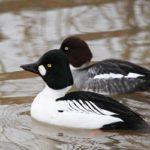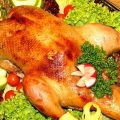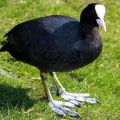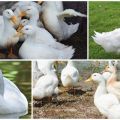Description and lifestyle of gogol ducks, habitats and taste
The wild duck, called gogol, is one of the duck species living in the forest zones of the Northern Hemisphere. The habitat is heterogeneous, that is, in some places this waterfowl is found in abundance, in others it is rare, and on the territory of some European states the duck settling places are closely connected with uninhabited or protected forest zones.
Where did the view come from
The gogol duck is found both in Eurasia and in America, but North America is considered its homeland. From here, her ancestors migrated to Asia, and then spread to the rest of the lands up to the western ends of Europe. This is a diving duck, which is not very numerous, but it is not a rarity either.
It is believed that there are two subspecies of the gogol duck:
- North American, larger.
- Eurasian.
They have no significant differences in appearance, behavior and nutrition. A nest is used as a nest, birds prefer the shores of forest rivers and lakes, do not form large flocks for migration, they winter on the coasts of seas and lakes, large rivers, estuaries.
Bird description
The gogol duck is a medium-sized bird, not exceeding 50 centimeters in length, strong, stocky, with a rounded head with noticeable feather "cheeks" and a smooth oval "tuft". As is usual in birds, female gogol ducks are smaller than males and have a more modest coloration.
They have a grayish-brown shade of plumage, the head is light brown, on the neck there is a white stripe with a ring, paws are yellowish in color, on the beak of some individuals there is a light orange bandage. The duck's weight ranges from 550 to 810 grams. Young gogols have the same color, regardless of their gender.

Males are distinguished by bright mating attire. Their lower body, sides and neck are snow-white, the top is black with peculiar stripes formed by wing feathers. The black head of the gogol duck has a characteristic "gasoline" overflow, white spots on the cheeks. The beak is black, the legs are orange. The mass of the drake is from 570 to 900 grams.
Lifestyle and habitat
The gogol duck prefers forest lakes, rivers, reservoirs, supplying them with food and shelter. Birds choose places where there are old hollow trees along the banks, which are necessary for nesting, but they calmly settle in artificial nests created for them by people. The gogol duck does not like open places, therefore it practically does not occur in the “bare” river floodplains.
For nests, the bird prefers to choose hardwood trees, but it can also use conifers, for example, pine. In the presence of a large number of hollows, the gogol duck prefers to keep the distance between the nests, but, if necessary, puts up with the forced crowding.
These are migratory birds, however, under favorable weather conditions and with an abundant food supply, they can remain for the winter. Most often these are single pairs of ducks or small groups of up to 5-6 individuals. In the northwestern part of Europe, there are few flocks of sedentary birds.
Ducks fly away early, from the end of August, but the bulk of birds go on a journey in the second half of October. They huddle in small flocks of 10-30 birds each.
In a number of countries, the gogol duck is considered a game bird, but in Belarus it is included in the Red Book.
What do they eat?
The diet of the gogol duck consists of aquatic invertebrates, which it catches at the bottom of a reservoir or in the water column. The duck is capable of diving to a depth of 10 meters, but prefers to settle on rivers and lakes with water up to 4 meters.
In winter, birds actively eat these molluscs and crustaceans. In summer, the menu of gogol ducks is much more varied. It includes bloodworms (mosquito larvae), midges, dragonflies, caddis flies, water beetles and other insects. Ducks also eat small fish, amphibians and earthworms, collect seeds and plant roots, and can peck at the green juicy parts of aquatic plants.

Reproduction and life expectancy
Birds arrive early, back in March. At the same time, the mating season of the gogol ducks begins. Most often, future pairs are laid even during wintering, but many gogols find a soul mate already in nesting places. The duck is sexually mature at the age of two. The period of "grooming" in birds is very bright and expressive. It was then that the drakes assume a characteristic pose with a proudly protruding chest and a raised head, which gave rise to the expression "walking with a gogol".
The gogol duck begins to build nests in the middle or late spring, choosing trees with hollows at a height of 10 to 15 meters. Prefers freestanding trees, but can also use artificial nests, and sometimes even abandoned burrows, for example, hare burrows. Often a nest is operated by the same pair or female for several years or decades in a row.
The bottom of the nest is covered with wood dust and laid out with down, which the female pulls out from her own breast. In a clutch there can be from 5 to 13 eggs, but more often their average number is 8-11 eggs. They are painted in a bluish or greenish-blue tint, large, up to 67 millimeters long and up to 46 millimeters wide.
Only the female incubates, the process lasts 29-30 days. The hatched chicks are wet, they dry out under the duck within 24 hours, then jump out of the nest on their own, regardless of the height. After 14 days, the ducklings regularly swim and dive, they can feed themselves without needing adult supervision, but they only get on the wing by two months. In nature, the gogol duck can live up to 20 years.
Taste qualities
Gogol duck belongs to the category of waterfowl. The meat has a characteristic taste and smell associated with the consumption of a specific food. To remove them from the carcass, duck skin is removed and fat is removed, and then soaked for 24 hours in a marinade based on wine vinegar.
Roasted or baked, this bird is delicious. Gogol duck does not differ in particular nutritional and taste value, it does not belong to the "red game", but it can serve as an ornament to any table.
Gogol eggs are tasty, but only a few pieces can be taken from the nest and only in those areas where the number of ducks is large.When using, you need to take into account the risk of infection with salmonella and other parasites, therefore, duck eggs are used only after heat treatment.















